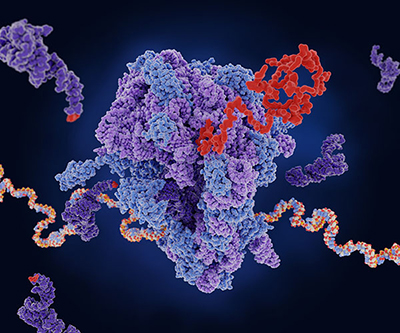
A ribosome (center) translates mRNA (multi-colored strand) into a protein (red). tRNA (dark purple) carries amino acids to add to the growing chain.
RNA synthesis, or transcription, is a fundamental process that transcribes the DNA instructions organized in genes, into specific RNA molecules. These RNAs can be messenger RNAs that are translated into proteins, or they can be other types, the non-coding (nc)RNAs that carry out many other functions in a cell. Transcription is a tightly regulated process that uses enzymes called RNA polymerases. Mutations in RNA polymerases can result in a variety of human conditions or diseases.
RNA Polymerase III (Pol III) specializes in transcribing genes that encode tRNA and other small ncRNAs. It can also transcribe RNA at higher rates than the other types of RNA Pols because of its structure and subunits, and how it interacts with its gene targets. Researchers, including those in the Maraia Lab, study the components of Pol III to better understand how it works, how it uniquely contributes to the health and function of a cell, and how it relates to the other RNA Pols.
Pol III is efficient at transcribing tRNAs because of how quickly it can turn itself “off” or terminate, and back “on” at a tRNA gene, a process called reinitiation-recycling. This cycling activity requires a subunit called C11. However, scientists are still refining knowledge of how C11 functions, although some data have been difficult to reconcile with an integrated model of Pol III transcription. In a recent study, the Maraia Lab advance an integrated model of Pol III activity that also accounts for previous inconsistencies.
In the study, the lab’s data suggest that the two domains of C11, called the N-terminal domain (NTD) and C-terminal domain (CTD), are capable of independent functions. The NTD can stimulate termination, meaning Pol III stops transcribing, while the CTD helps process the transcript in a step called 3’-cleavage. However, when both domains are connected by a highly conserved essential linker, they provide the critical reinitation-recycling activity that is unique to Pol III among RNA polymerases. Their findings demonstrate that the NTD-Linker is sufficient for reinitation-recycling and the in vivo function of C11, which differ from previous studies that suggest that the CTD and its 3’-cleavage activity were essential. Overall, the new data resolves misunderstanding of C11 and helps advance knowledge of Pol III.
 BACK TO TOP
BACK TO TOP